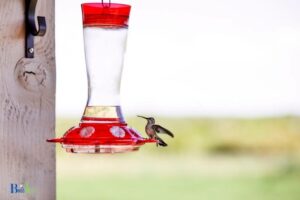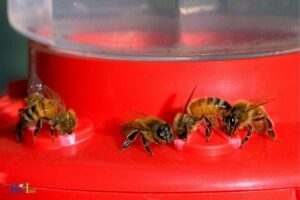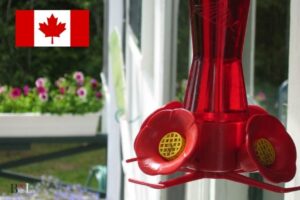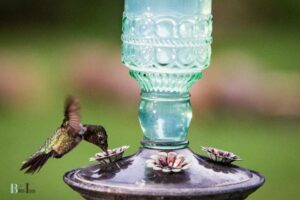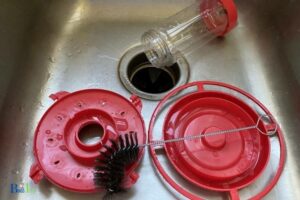Will Hummingbirds Come to My Feeder: Yes!
Yes, hummingbirds will come to your feeder if it is properly placed, filled with the right nectar, and consistently maintained.
Hummingbirds are attracted to feeders that provide them with the necessary nutrients they need for their high-energy lifestyle.
By ensuring that your feeder is clean, filled with an appropriate sugar-water mixture, and situated in a safe and visible location, you can successfully attract these fascinating creatures to your outdoor space.
Additionally, try to place the feeder near a window or seating area where you can easily observe the activity and enjoy the beauty of these fascinating birds.
By providing a safe, enticing environment, hummingbirds will be more likely to visit your feeder on a regular basis.
6 Factors: Hummingbirds Come to My Feeder
| Factors | Yes – Will Attract Hummingbirds | No – Will Not Attract Hummingbirds |
| Feeder Type | Bright colored, easy to clean | Dull colored, hard to clean |
| Feeder Location | Near flowers, shaded area | Hidden, high traffic area |
| Nectar Recipe | 4:1 water to sugar ratio | Artificially flavored, colored |
| Feeder Cleanliness | Clean and filled regularly | Dirty, moldy, or empty |
| Nearby Pesticides/Insecticides | Avoid use near feeder | Frequent use near feeder |
| Nearby Plants/Flowers | Hummingbird-friendly flowers | No plants or non-attractive flowers |
Key Takeaway
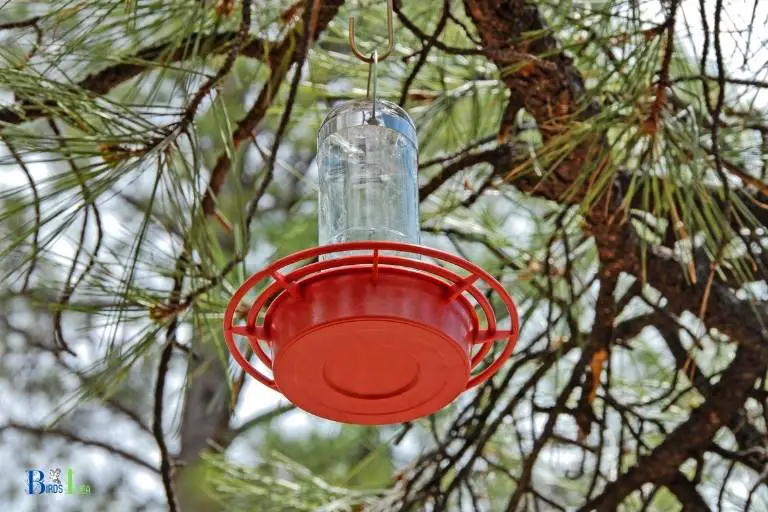
Facts About: Hummingbirds Come to Feeder
Understanding Hummingbirds Habitat Needs
Hummingbirds are delightful little creatures that can bring life to any garden or backyard. Filling up a hummingbird feeder with nectar is an easy way to attract them, but will they actually come?
Understanding hummingbirds’ habitat needs is crucial to attract and keep them.
In this post, we’ll cover the hummingbird diet, nesting requirements, and creating a welcoming environment.
Hummingbird Diet
Hummingbirds have a highly specialized diet that consists mainly of nectar from flowers and small insects for protein.
Here are some key points to remember when it comes to feeding hummingbirds:
- Hummingbirds need to eat frequently, so your feeder should always have fresh nectar.
- The nectar should be a mixture of four parts water to one part white granulated sugar. Avoid using artificial sweeteners, honey, or brown sugar, as they may harm the birds.
- Red food coloring should never be added to the nectar, as it can be harmful to hummingbirds.
- Change the nectar every three to four days and clean the feeder with hot water and soap before refilling it.
Requirements For Nesting
Hummingbirds are known for their unique nests, which are often tiny cups made of feathers, moss, and spiderwebs.
Here are a few things to keep in mind if you want to provide a welcoming nesting environment for hummingbirds:
- Hummingbirds prefer to nest in sheltered areas such as trees or shrubs that provide shade and protection from the wind.
- They like to build their nests close to a source of food, so placing your feeder near a good flowering plant will encourage them to nest close by.
- To help entice hummingbirds to nest in your yard, you can provide materials like cotton, soft string, and pet fur for them to use to build their nests.
Creating A Welcoming Environment
Attracting and keeping hummingbirds requires more than just a feeder filled with nectar.
Here are a few tips to create a welcoming environment:
- Plant a variety of brightly colored flowers that bloom throughout the season. Hummingbirds are attracted to red, orange, and pink flowers with tubular shapes.
- Provide perches near your feeder, as hummingbirds need a place to rest between flights.
- Keep your feeding area clean and free of ants or wasps, as these pests can deter hummingbirds from visiting.
Understanding hummingbirds’ habitat needs is essential to attract and keep these amazing birds in your yard. By providing a healthy diet, safe nesting areas, and a welcoming environment, you can enjoy the delightful presence of hummingbirds all season long.
Providing The Right Feeder
Will Hummingbirds Come To My Feeder: Providing The Right Feeder
Feeding hummingbirds is a great way to enjoy these beautiful birds in your backyard.
But to attract hummingbirds to your feeder, you have to provide the right feeder that meets their specific needs.
Here are some key considerations to keep in mind when choosing a hummingbird feeder.
Feeder Capacity And Size
Hummingbirds are known for their fast metabolism and high energy level. They eat a lot and often, consuming up to twice their body weight in food each day.
Therefore, it’s crucial to choose a feeder that can hold an adequate amount of nectar to sustain them.
Here are some things to note:
- Choose a feeder that can hold at least eight ounces of nectar.
- Consider the number of hummingbirds you want to attract. If you want to enjoy multiple birds at once, choose a feeder with multiple feeding ports.
- Pick a feeder that is easy to clean. The larger the feeder, the more difficult to clean, so keep that in mind when deciding on the size.
Feeder Color And Shape
The color and shape of the feeder can also affect its appeal to hummingbirds.
Here’s what to keep in mind:
- Choose a feeder with bright and bold colors, such as red, orange, or pink. These colors are most attractive to hummingbirds as they associate them with the color of flowers.
- Avoid yellow feeders, as these are typically less attractive to hummingbirds.
- The shape of the feeder should be long and slender, resembling the shape of flowers that hummingbirds love to feed on.
Choosing The Right Location
The location of the feeder is just as important as the feeder itself.
Here are some tips to help you choose the right spot:
- Choose a location that is easily visible, either from inside your home or from a patio or deck.
- Place the feeder away from windows to prevent hummingbirds from colliding with them.
- Hang the feeder in a shaded area to prevent the nectar from spoiling too quickly.
- Hang the feeder at a height of 4-5 feet from the ground to keep the feeder out of reach of predators.
Providing the right feeder is crucial in attracting hummingbirds to your backyard. Remember to choose a feeder with a proper capacity, color, and shape, and to place it in the right location.
With a little extra effort and some patience, you’ll soon be enjoying the delightful presence of hummingbirds in your backyard.
Nectar Recipe For Attracting Hummingbirds
Hummingbirds are fascinating creatures to watch and attract to our yards. With their vibrant colors and rapid wing movements, hummingbirds are a delight for any nature lover.
If you’re wondering if hummingbirds would come to your feeder, the answer is yes! By providing them with the right nectar, you can welcome these tiny birds to your garden and watch them delight in the sweet treat.
Homemade Nectar Recipe
Making hummingbird nectar is easy and simple.
The recipe requires just two ingredients:
- 1 part white granulated sugar
- 4 parts water
To make the nectar, follow these steps:
- Mix the sugar and water in a pot.
- Bring the mixture to a boil while stirring occasionally.
- Let it cool and then pour it into your hummingbird feeder.
Avoid using honey, artificial sweeteners, or red food coloring. Honey can promote the growth of harmful bacteria, while artificial sweeteners lack nutritional value.
Red food coloring can be harmful to hummingbirds.
Preparing & Storing Nectar
It’s crucial to keep your hummingbird feeder clean to avoid contamination and illness for the birds.
Here are some tips to prepare and store nectar properly:
- Use a clean, sanitized feeder. Clean the feeder every time you refill it with fresh nectar.
- Boil the water before mixing it with sugar to eliminate any bacteria in the water.
- Store any leftover nectar in the refrigerator for up to a week.
- Do not fill your feeder completely full; instead, leave a little room for the nectar to expand when the temperature increases.
It’s also essential to keep an eye on the nectar and check for signs of spoilage, such as cloudiness, a sour smell, or mold.
If you notice any of these signs, discard the nectar and clean the feeder thoroughly before refilling it with fresh nectar.
Attracting hummingbirds to your garden is a simple and fun way to add some natural beauty to your yard.
By making your nectar and following proper nectar preparation and storage techniques, you can enjoy the company of these adorable birds for years to come.
So, what are you waiting for? Go and prepare some delicious nectar for your feathered friends and enjoy their visit.
Maintenance & Cleaning
Hummingbirds are fascinating creatures that enchant us with their beauty and impressive acrobatic talents.
Whether you are an experienced bird watcher or a beginner, you might be wondering whether hummingbirds will come to your feeder. The good news is, it is entirely possible to attract these little wonders to your backyard.
But to ensure that your feeder gets regular visits, you need to maintain and clean it properly. In this blog post, we will discuss the key strategies to take care of your feeder.
Regular Cleaning Routine
To keep your hummingbird feeder clean and fresh, you need to have a regular cleaning routine.
Here are some tips to guide you:
- Clean your feeder at least once a week, and more frequently during hot weather.
- If the nectar has not been consumed after a week, dump it out and replace it with fresh nectar.
- To clean the feeder, use hot water and a mild soap or vinegar solution.
- Rinse your feeder thoroughly to ensure that no soap residue is left behind.
- Use a bottle brush or a toothbrush to clean the small crevices or ports that might be hard to reach.
- If you notice signs of mold or mildew, discard the feeder and purchase a new one.
Prevention Of Insect Infestation
One of the biggest challenges of maintaining a hummingbird feeder is preventing insect infestation, especially ants and bees.
Here are some tips to keep insects away:
- Hang your feeder high above the ground to avoid ants and other crawling insects.
- Use an ant moat or an ant trap to keep ants away from your feeder.
- Choose a feeder with bee guards or add them to your existing feeder.
- Avoid using yellow or orange colored feeders as they attract bees and wasps.
- Place your feeder in a shaded area to minimize the attraction of bees.
Avoiding Hazards
While your feeder is meant to attract hummingbirds, it can sometimes become a danger to them and other birds.
Here are some ways to avoid hazards:
- Choose a feeder with removable perches or use a feeder that does not have them. Perches can be a hazard for hummingbirds as larger birds might use them to attack the smaller ones.
- Keep your feeder away from windows to avoid bird collisions, which can be fatal.
- Use a feeder with a red base, as red attracts hummingbirds and helps them locate the feeder quickly.
Hummingbirds are fascinating birds that we can attract to our backyard by maintaining a clean and proper feeder.
A regular cleaning routine, prevention of insect infestation, and avoiding hazards are key to making your feeder an attractive spot for these little wonders.
So grab your feeder, follow the tips above, and enjoy the magic of hummingbirds in your backyard.
Factors To Consider
Factors To Consider: Will Hummingbirds Come To My Feeder?
Do you enjoy watching hummingbirds? Would you like to attract them to your garden? You are not alone!
Thousands of bird lovers are trying to draw these beautiful creatures to their yards worldwide. Hummingbirds are fascinating to watch, thanks to their ability to fly forward, backward, and hover.
Even more impressive, they flap their wings up to 80 times per second! In this blog post, we’ll discuss some critical factors to consider when trying to attract hummingbirds to your feeder.
Geographical Location And Climate
Hummingbirds are found in the western hemisphere, and their preferred locations have a warm, humid, and tropical climate.
However, some species, such as the ruby-throated hummingbird, are migratory and travel thousands of miles every year. When trying to attract hummingbirds, consider your location concerning their migration path.
Key points:
- Hummingbirds prefer warm, humid, and tropical climates
- Some species are migratory, and therefore, you need to consider migration paths
Availability Of Hummingbird Resources In Your Region
Hummingbirds require feeders, flowers, and water to survive. If you live in an area without these resources, it may be difficult to attract them to your feeder.
In such cases, you could incorporate hummingbird-friendly plants in your garden. Keep in mind that they are attracted to bright colors such as red, pink, and orange.
Remember to keep these flowers high in nectar content, such as bee balm, salvia, coral honeysuckle, and scarlet sage.
Key points:
- Hummingbirds require feeders, flowers, and water
- Plant flowers with high nectar content and bright colors to attract hummingbirds
Proper Advertising Of Your Feeder
Once you have ensured that your location and feeder resources are suitable, the next thing to consider is how to advertise your feeder to hummingbirds.
To do this, place your feeder in an open space that can be seen from a distance.
Use proper hanging mechanisms to ensure the feeder doesn’t move around too much and make sure the feeder is clean to prevent disease.
Preparing nectar at home is best for the environment and your wallet. Keep the nectar fresh, and don’t use additives such as food coloring as it can cause harm to the birds.
Key points:
- Ensure the feeder is in an open space to advertise to hummingbirds
- Use proper hanging mechanisms
- Preparing nectar at home will save you money and is better for the environment
Attracting hummingbirds to your feeder can be a fun and rewarding experience. However, it takes a bit of effort, patience, and the understanding of the factors mentioned above.
Make sure to care for your birds and enjoy the beautiful sights they offer!
Tips To Increase Your Chances Of Attracting Hummingbirds
Will hummingbirds come to my feeder: tips to increase your chances of attracting hummingbirds
Hummingbirds are one of the smallest and most beautiful birds in the world. They are very active and always on the lookout for nectar, their primary food source.
If you’re a bird watcher or just someone who loves nature, you might be wondering if hummingbirds will come to your feeder.
Here are some tips on how to increase your chances of attracting hummingbirds to your feeder.
Placing A Variety Of Feeder Types
Different types of feeders can attract different species of hummingbirds.
Here are some of the best feeder types to hang in your yard:
- Bottle feeder: This feeder has a bottle with a small opening that releases nectar as hummingbirds drink from it.
- Saucer feeder: This type of feeder has a shallow dish with a small hole in the center.
- Tube feeder: This feeder has long, narrow tubes that allow hummingbirds to feed comfortably.
You can also find unique feeders that are designed to mimic a flower that hummingbirds may find more attractive.
Reducing Competing Food Sources
Hummingbirds are territorial, so if you have other food sources in your yard, it might be challenging to attract them to your feeder.
Here are some tips to reduce competition:
- Remove any other sugar sources in your yard, such as flower nectar and juice feeders.
- Keep your feeder away from other bird feeders, preferably in a separate area altogether.
Using A Hummingbird Camera And Hummingbird Tracker
To get a close-up of hummingbirds, use a hummingbird camera to capture their movements and activities. You can find a lot of inexpensive options in stores or online. Additionally, using a hummingbird tracker can help you identify species and monitor your yard’s activity.
Understanding hummingbirds’ feeding behaviors and preferences is crucial to attract them to your yard.
By providing a variety of feeder types, reducing competing food sources, and using a hummingbird camera and tracker, you can increase your chances of attracting and observing these magnificent creatures.
Best Time Of Year To Attract Hummingbirds
Seasonal Changes That Affect Hummingbird Activity
Hummingbird activity varies throughout the year, and understanding these seasonal changes is crucial to attracting these colorful creatures to your feeder.
- Spring: Hummingbirds begin their migration from central america to the northern parts of north america in the spring. As they travel through different regions, they’ll need to refuel on nectar from feeders. In march or april, you can start to hang feeders for early bird hummingbirds.
- Summer: This is the peak season for hummingbird activity, as they breed and raise their young. During this time, you may see an increase in the number of hummingbirds visiting your feeder.
- Fall: As the days get shorter and the temperature cools down, hummingbirds will begin their journey back to warmer climates. Make sure to keep your feeder up until they all leave, usually around september or october.
- Winter: Many species of hummingbirds are migratory, so you won’t see them during the winter months. However, some non-migratory species, such as anna’s hummingbirds, will stay put. Keep your feeder filled with fresh nectar throughout the year to cater to these “resident” hummingbirds.
Timing Your Feeder Placement And Nectar Changes
Hummingbirds have an incredible memory and will often return to the same feeder year after year.
To increase the chances of attracting hummingbirds, it’s crucial to get your feeder placement and nectar changes just right.
- Feeder placement: Choose a location that is easily visible and away from windows, as collisions can be fatal for hummingbirds. Also, avoid placing your feeder near a bird bath, as the splashing water can dilute the nectar.
- Nectar changes: Change your nectar every 3-4 days, even if the feeder is not empty or if the temperature is cooler. In warmer weather, change the nectar more frequently to prevent spoilage. To make nectar, mix one part white granulated sugar with four parts water. Do not add food coloring, honey, or artificial sweeteners.
By following these tips, you’ll be able to attract hummingbirds to your feeder throughout the year. Enjoy watching these fascinating birds as they zip around your yard, sipping on sweet nectar.
Troubleshooting Common Problems
Lack Of Hummingbird Activity
If you have a hummingbird feeder but aren’t seeing any hummingbirds, don’t fret.
Here are some possible reasons and solutions:
- Distance: If your feeder is too far away from the birds’ natural habitat, they may not be able to find it. Move the feeder closer to natural nectar sources like flowers or trees.
- Season: Hummingbirds migrate and may not be in your area at the moment. You can check migration calendars to determine when they’ll return.
- Competition: Other food sources in the area may be more enticing to the birds. Try using a different type of nectar, or moving your feeder to a less crowded location.
Aggressive Hummingbird Behavior
Sometimes, hummingbirds can get territorial and aggressive.
If you’re experiencing this issue, try these methods to prevent it:
- Get more feeders: Having multiple feeders spaced out can help reduce competition and minimize territorial behavior.
- Move the feeder: If one particular bird seems to be dominating, move the feeder slightly to a new location. This can give other birds a chance to access it.
- Add more nectar: Providing more food for the birds can reduce competition and calm them down.
Pest Control And Prevention
Hummingbird feeders can attract more than just birds. Insects like ants and bees may get into the nectar, causing problems. Here’s how to prevent pests:
- Ants: Use an ant moat or a special feeder with an ant guard to keep ants at bay. Placing some petroleum jelly on the feeder pole can also help prevent ants from climbing up.
- Bees: Use feeders with bee guards or place the feeder in an area where bees are less likely to be attracted. You can also try using a more concentrated nectar mixture, as bees are more attracted to weaker concentrations.
- Wasps: Unlike bees, wasps can easily access hummingbird feeders with bee guards. Try hanging a fake wasp nest nearby to deter them. Additionally, trimming any nearby bushes or branches can make it more difficult for wasps to get to the feeder.
By troubleshooting these common problems, you can create a more welcoming environment for hummingbirds and enjoy their visits to your feeder.
FAQ On Will Hummingbirds Come To My Feeder
How Can I Attract Hummingbirds To My Feeder?
What Is The Best Type Of Feeder For Hummingbirds?
What Is The Ideal Location To Hang A Hummingbird Feeder?
How Often Should I Clean My Hummingbird Feeder?
Conclusion
After reading this post, it’s clear that attracting hummingbirds to your backyard is easier than you might think.
With the right feeder and nectar, ample space for the birds to feed and perch, and some basic knowledge of their habits and preferences, you can create an inviting environment for these beautiful creatures to visit.
Whether you live in a rural area or a bustling city, there’s a good chance that hummingbirds will find your feeder if you take the time to set it up properly and maintain it throughout the season.
By welcoming these tiny birds into your space, you’ll not only enjoy a lovely natural spectacle, but you’ll also be supporting their important role in pollination and ecosystem health.
Try setting up a hummingbird feeder today and see what kind of visitors you can attract!

